On & Off the Hill
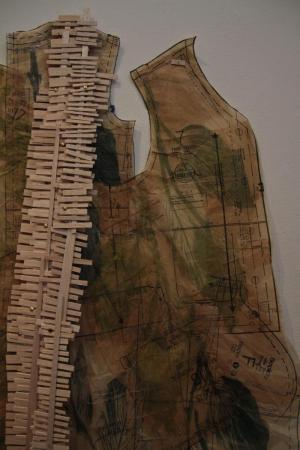 Learn about new faculty members, a journey to Cambodia, responses to Tropical Storm Irene, events in theater and film, notable students, faculty and staff, and more. Marlboro community members are everywhere.
Learn about new faculty members, a journey to Cambodia, responses to Tropical Storm Irene, events in theater and film, notable students, faculty and staff, and more. Marlboro community members are everywhere.
New faculty members bring fresh ideas in music, writing
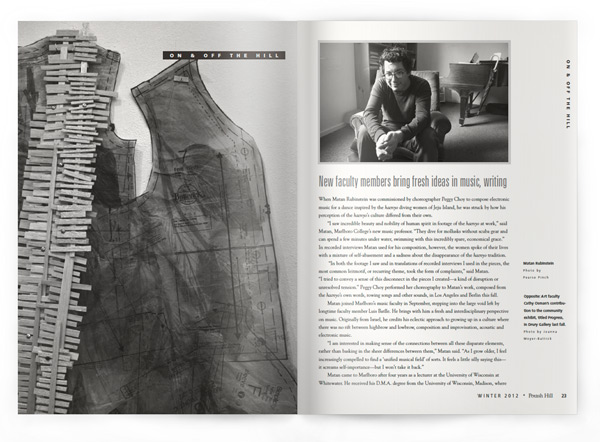
When Matan Rubinstein was commissioned by choreographer Peggy Choy to compose electronic music for a dance inspired by the haenyo diving women of Jeju Island, he was struck by how his perception of the haenyo’s culture differed from their own.
“I saw incredible beauty and nobility of human spirit in footage of the haenyo at work,” said Matan, Marlboro College’s new music professor. “They dive for mollusks without scuba gear and can spend a few minutes under water, swimming with this incredibly spare, economical grace.” In recorded interviews Matan used for his composition, however, the women spoke of their lives with a mixture of self-abasement and a sadness about the disappearance of the haenyo tradition.
“In both the footage I saw and in translations of recorded interviews I used in the pieces, the most common leitmotif, or recurring theme, took the form of complaints,” said Matan. “I tried to convey a sense of this disconnect in the pieces I created—a kind of disruption or unresolved tension.” Peggy Choy performed her choreography to Matan’s work, composed from the haenyo’s own words, rowing songs and other sounds, in Los Angeles and Berlin this fall.
Matan joined Marlboro’s music faculty in September, stepping into the large void left by longtime faculty member Luis Batlle. He brings with him a fresh and interdisciplinary perspective on music. Originally from Israel, he credits his eclectic approach to growing up in a culture where there was no rift between highbrow and lowbrow, composition and improvisation, acoustic and electronic music.
“I am interested in making sense of the connections between all these disparate elements, rather than basking in the sheer differences between them,” Matan said. “As I grow older, I feel increasingly compelled to find a ‘unified musical field’ of sorts. It feels a little silly saying this—it screams self-importance—but I won’t take it back.”
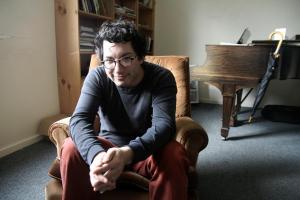 Matan came to Marlboro after four years as a lecturer at the University of Wisconsin at Whitewater. He received his D.M.A. degree from the University of Wisconsin, Madison, where his dissertation piece was a composition for electronic sound and large chamber ensemble entitled Le Invisibili. This work, a modular piece comprising 35 musical segments that can be combined 27,300 ways, was the culmination of a decade of creating musical compositions that can be radically different with every performance.
Matan came to Marlboro after four years as a lecturer at the University of Wisconsin at Whitewater. He received his D.M.A. degree from the University of Wisconsin, Madison, where his dissertation piece was a composition for electronic sound and large chamber ensemble entitled Le Invisibili. This work, a modular piece comprising 35 musical segments that can be combined 27,300 ways, was the culmination of a decade of creating musical compositions that can be radically different with every performance.
Matan brings a wide range of talents and experiences to Marlboro and is a prolific composer of music that is diverse in practice, medium and method. He is a frequent collaborator with artists in other disciplines, and he often makes music for dance and film. Some recent examples include Palimpsest for trombone and “tape,” commissioned by trombonist Michael Dugan; Knotcracker, commissioned by the Li Chiao-Ping Dance Company; and the score for Verge, a dance film directed by Douglas Rosenber. Matan is an active performer, having founded both the Sada Jazz Trio and the Modular Music Ensemble, and has several recordings to his credit. He is also a passionate teacher with interests that span many disciplines.
“Teaching music is the best way I know of to prove the infinite ways in which people conceive of and hear music,” he said. “Every time I teach a piece of music, someone brings a distinctly different way of hearing it. I can never be bored with my vocation this way.”
Marlboro’s interdisciplinary approach similarly resonates with new writing professor Kyhl Lyndgaard. “When I saw the titles of recent Marlboro course offerings and student Plans, I was amazed at how diverse and vibrant the academics were,” said Kyhl, who also joined the community in September. “My initial pleasure in learning about Marlboro gave rise to a strong desire to be amidst those catalog listings. This was a chance to challenge disciplinary boundaries on a daily basis and join a community that is built around flexibility of inquiry.”
 Kyhl came to Marlboro from Luther College, in Iowa, where he spent a year as an Associated Colleges of the Midwest–Mellon postdoctoral fellow in English and environmental studies. He received his Ph.D. in English with an emphasis in literature and environment from the University of Nevada at Reno. His dissertation, titled “Landscape of Removal and Renewal: Cross-Cultural Resistance in 19th-Century American Captivity Narratives,” is currently under review by the University of Oklahoma Press. It examines a handful of subversive Indian captivity narratives published in the 1820s and 1830s that challenge Indian Relocation Act policies and depict the frontier wilderness as a domestic and inhabited space. Kyhl also co-edited an anthology entitled Currents of the Universal Being: Explorations in the Literature of Energy, which had its genesis in a student seminar, forthcoming from Texas Tech University Press. He has written many articles and chapters on literature, writing pedagogy and the natural world, as well as reviews, nonfiction and poetry.
Kyhl came to Marlboro from Luther College, in Iowa, where he spent a year as an Associated Colleges of the Midwest–Mellon postdoctoral fellow in English and environmental studies. He received his Ph.D. in English with an emphasis in literature and environment from the University of Nevada at Reno. His dissertation, titled “Landscape of Removal and Renewal: Cross-Cultural Resistance in 19th-Century American Captivity Narratives,” is currently under review by the University of Oklahoma Press. It examines a handful of subversive Indian captivity narratives published in the 1820s and 1830s that challenge Indian Relocation Act policies and depict the frontier wilderness as a domestic and inhabited space. Kyhl also co-edited an anthology entitled Currents of the Universal Being: Explorations in the Literature of Energy, which had its genesis in a student seminar, forthcoming from Texas Tech University Press. He has written many articles and chapters on literature, writing pedagogy and the natural world, as well as reviews, nonfiction and poetry.
“An essay I’m planning to read at a conference in Alaska next summer will somehow combine Hurricane Irene, Thoreau’s Maine Woods, climate change and ideas of freedom and community in early and present-day America,” said Kyhl. “This list of topics suggests that Marlboro’s interdisciplinary approach to academics has influenced me already.”
Kyhl believes that good writing depends on confidence and the freedom to speak your own mind, and he creates a classroom environment that fosters a sense of personal responsibility
“Individuality in thought and expression is all too rare and undervalued these days, and I can’t imagine working anywhere but a small liberal arts college,” he said. “Marlboro’s small size is a real asset in forging the sorts of alliances and creative solutions needed to offer flexibility in student tutorials and Plans.”
Kyhl’s choices in course readings often emphasize literature that has inspired action. Dan Phillippon’s Conserving Words, for example, traces how nature writers have directly influenced the creation of environmental groups, as in the case of John Muir and the Sierra Club or Mabel Osgood Wright and the Audubon Society. “Teaching literature that has had direct and often measurable influences on policy and public attitudes shows students the power of language,” Kyhl said.
Both Kyhl and Matan are already active participants in the Marlboro community. Matan jumped immediately into participating in Town Meeting, giving the traditional annual plea for driving carefully on South Road, and played Copland and Gershwin processionals for Convocation. Kyhl led a group of students to do hurricane relief work for Marlboro residents on Augur Hole Road, and hit the go-ahead home run in the faculty-student softball game. The community welcomes these additions, and looks forward to their many and varied contributions to come.
Marlboro Returns to Cambodia
 Last May, Marlboro community members took part in the second service-learning trip to Cambodia in the past three years, building on relationships from the last visit and forging new ones. For two weeks, art faculty John Willis and Cathy Osman as well as Max Foldeak, director of health services, were joined by seven students as they visited communities, participated in ESL classes in local schools and helped with water projects.
Last May, Marlboro community members took part in the second service-learning trip to Cambodia in the past three years, building on relationships from the last visit and forging new ones. For two weeks, art faculty John Willis and Cathy Osman as well as Max Foldeak, director of health services, were joined by seven students as they visited communities, participated in ESL classes in local schools and helped with water projects.
“Going to Cambodia completely changed the way I look at the world, and specifically the way I look at America,” said senior Nick Rouke. “It was the first time I had left the country, and it was incredibly difficult. It made me realize what I take for granted.”
Before their trip, the group initiated a community-wide auction of paintings, prints, photos, books, ceramics and other artwork created by students and faculty to raise $2,500 in aid for organizations in Cambodia. They also brought children’s books, medications and medical equipment, including nearly a thousand pairs of eyeglasses, donated from many local sources, as well as 30 laptop computers donated by Pfizer, Inc. Donations were processed through the World Peace Fund and the Amherst/Cambodia Water project. In-kind donations were brought by the group directly to schools in Kampong Chhnang, Ang, Pursat, Omani, Siem Reap and other communities where they participated in service projects.
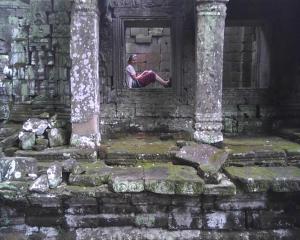 In addition to their work in communities, the group from Marlboro visited the capital of Phnom Penh, the temples at Angkor and memorials to those killed during the Khmer Rouge period.
In addition to their work in communities, the group from Marlboro visited the capital of Phnom Penh, the temples at Angkor and memorials to those killed during the Khmer Rouge period.
“We visited Tuol Sleng, a school that Pol Pot converted into a prison where he tortured and killed people,” said Nick, who had previously studied captivity and totalitarian regimes in other contexts. “People would be killed for disagreeing, much like the purges during the Stalinist era. It was very difficult to be there, but it made me really think about the things I have studied during my time here at Marlboro, why they are important to me, and what I want to do about it.”
Marlboro responds to flood damage
The Marlboro community will not soon forget the day in late August when Tropical Storm Irene destroyed local roads and cut the college off from the rest of the world for days. But perhaps more remarkable than the college’s resilience during and after the storm was the response to neighboring communities where the flooding wreaked even more havoc.
As early as September 3, just a week after the storm, a group of 21 Marlboro students and staff participated in the United Way Day of Caring. This was an event planned long before the flooding, and most of the projects for large groups did not directly involve flood relief. However, the outpouring of support was essential to the nonprofits that provide much-needed programs in the region, and a boon to the local efforts of the United Way. Marlboro students helped scrape and paint facilities at Green Mountain Girls Camp in Dummerston, Farming Connections in Guilford and Living Memorial Park Snow Sports in Brattleboro. Several students helped at Glen Park, on Western Avenue, a mobile home park for elderly residents that was damaged by floodwaters.
“It was one of the toughest, nastiest jobs anyone has had to face,” said Christine Forbes, whose 95-year-old mother, Alice Joslin, was one of the Glen Park residents helped by students. “Not only was the job completed, but they were so pleasant to her and made the job almost fun. I will long remember the happiness in her voice when she talked about these students. They were truly extraordinary young folks.”
The following weekend, as most of the local roads became passable, Marlboro’s new writing professor, Kyhl Lyndgaard, led a group of three students and one parent of a former student to the hardest-hit road in Marlboro, Augur Hole Road. There they helped remove silt from the residence that was once the Branch Schoolhouse.
“For all of us, the storm was a new and shocking experience,” said Kyhl. “But the washed-out roads have been more than matched by the resilience of Marlboro residents.”
On September 24, more than 70 students, faculty and staff joined together at Whittemore Theater to be part of the world’s largest poetry reading, 100,000 Poets for Change, an event that brings poets and other artists together to perform simultaneously around the world. The local effort, which directly supported United Way disaster relief and benefited victims of the storm, featured readings and performances by receptionist Sunny Tappan ’77, writing professor John Sheehy, senior Gina Ruth and junior Jack Rossiter-Munley, who organized the evening. It also included a silent auction and bake sale, and altogether raised more than $700 for local flood relief efforts.
Finally, a fund drive that started as a dare between two students ended with a total donation of $5,139 for the United Way of Windham County. When senior Anna Hughes offered to pay junior Chuck Pillette to dye his hair blue, they decided to up the ante and raise money for those affected by the flooding as well as others in need. Jodi Clark ’95, director of housing and residential life, was planning the traditional employee fundraising effort for the United Way when Anna asked for help getting her campaign going.
“It simply seemed like a great way to accomplish both the employee campaign and this student-led idea by combining them to make it a whole campus community campaign,” said Jodi. The resulting “Green for Blue” fund drive involved 17 prominent community members who promised to dye their hair blue if donations reached a certain level. While the campaign raised just $500 less than the goal of $5,000—the point at which Marlboro President Ellen McCulloch-Lovell pledged to go blue—a final push by faculty and students at the graduate school brought the total above that mark.
Events feature futuristic theater, Chinese cinema
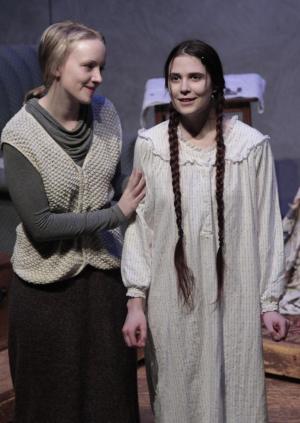 In November, the theater program presented two contemporary one-act plays by Caryl Churchill at Whittemore Theater, rounding out a full semester of events. The plays, Far Away and A Number, were directed by guest director Anna Bean, who worked with Marlboro students to present The Clean House last fall.
In November, the theater program presented two contemporary one-act plays by Caryl Churchill at Whittemore Theater, rounding out a full semester of events. The plays, Far Away and A Number, were directed by guest director Anna Bean, who worked with Marlboro students to present The Clean House last fall.
“This year I chose these two one-acts by Churchill, a British playwright whose work I find witty and chilling at the same time,” said Anna, who teaches at the Berkshire Arts and Technology Charter Public School and at Community College of Vermont in Bennington. “I saw both Far Away and A Number during their New York runs, and they have both haunted me with their tales of foreboding about the future. I thought I would see if we could create the same effect at Marlboro.”
Although both plays are set in the future, it’s a not-so-distant future that feels easily within reach. Far Away takes place in a post-apocalyptic world, where the heroine hat-maker negotiates her way, one precarious step at a time, while A Number centers around a father who made the choice long ago to clone his son.
“Both plays deal with themes of paranoia, war, fear—all of which are very present in our current culture,” said junior Kirsten Wiking, one of the students featured in the productions. Also included were sophomore Courtney Varga, sophomore Luc Rosenthal, junior Evan Lamb and freshman Luke Benning. “There’s a very real feel to the events in them, even if there are absurd elements,” continued Kirsten. “Because there’s a feeling of ‘this could be real,’ it was easy as a performer to tap into the fear or feeling of the events of the play.”
Also in November, the Asian studies program presented a weekend-long film festival titled Contemporary Landscapes of China. The six films showcased some of the best new films from China, including both features and documentaries, dealing with a range of contemporary social and environmental issues. For example, Before the Flood profiles people whose livelihoods are destroyed by the Three Gorges Dam, and Last Train Home documents the massive internal migration from China’s poorer inland provinces to the new industrial heartland. Each film was accompanied by a discussion led by authorities on the subject, including Asian studies professor Seth Harter, economics professor Jim Tober, Chinese language professor Grant Li and alumnus Tristan Roberts ’00.
For news about upcoming events, go to www.marlboro.edu/news/events.
A goddess slinks into eternity
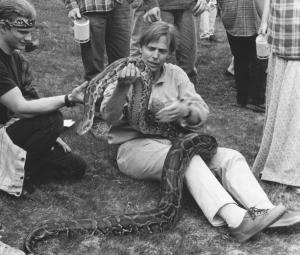 Those who frequent the science building are missing Kali, the 13.5-foot Burmese python, who passed away in September. Kali was six feet long when she was first introduced to the college 22 years ago by science faculty John Hayes and Jenny Ramstetter, despite the misgivings of their colleague Bob Engel.
Those who frequent the science building are missing Kali, the 13.5-foot Burmese python, who passed away in September. Kali was six feet long when she was first introduced to the college 22 years ago by science faculty John Hayes and Jenny Ramstetter, despite the misgivings of their colleague Bob Engel.
“Bob’s reservations gradually waned, and the python became a beloved resident of the science building among parrots, finches, turtles, lizards and exotic birds over the years,” said Jenny. “Bob and John named her Kali, after the Hindu goddess of destruction, and there were many jokes about how slacking Plan students might end up in the python area.”
Despite the jokes, Kali was a gentle soul who had many admirers and regular visitors: young kids from the community, surprised prospective students and of course devoted science students and faculty members. “Other translations of her Hindu name are more fitting: Kali, the ‘goddess of time and change’ and ‘goddess of eternal energy,’” said Jenny. “We will miss Kali.”
And more
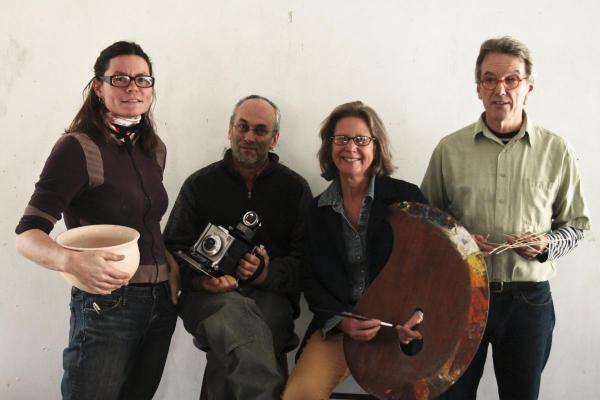
A group show at the Brattleboro Museum and Art Center, featuring new work by Marlboro art faculty Marina Lantin (ceramics), John Willis (photography), Cathy Osman (painting) and Tim Segar (sculpture), opened in November. Titled Four Eyes: Art from Potash Hill, the show will continue through February 5. Photo by Joanna Moyer-Battick
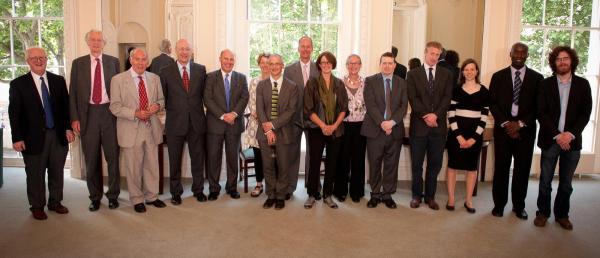
Last June, a few of Marlboro’s former Oxford classics fellows, math fellows and alumni gathered with Ellen McCulloch-Lovell, president, Ted Wendell, trustee, and Mary Wendell for a reunion at the British Academy in London. Those attending included (from left to right) Ted Wendell, Nicolas Barber, Geoffrey Fallows, Robin Jackson, David Middleton, former math fellow Charlotte Watts, ecologist Chris Carbone ’88, Robert Wendt, artist Pat Kauffman ’74, Ellen McCulloch-Lovell, Mark Pobjoy, Philip DeMay, Emma Park, former math fellow John Arhin and current classics fellow William Guast. Photo by Claudine Hartzel
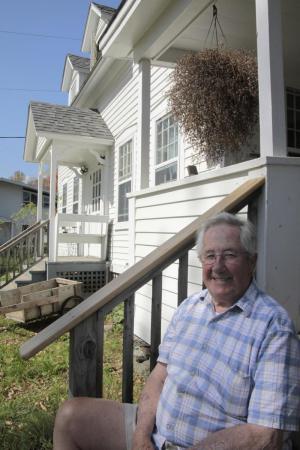 John MacDonald of Shaftsbury, Vermont, who was born in Hendricks House in 1927, stopped by the campus for a visit in October. His family owned 1,300 acres here and farmed and logged the land. After his father died, his mother, pregnant with twins, sold the farm to Marlboro founder Walter Hendricks and moved to the Northeast Kingdom. Photo by Dianna Noyes
John MacDonald of Shaftsbury, Vermont, who was born in Hendricks House in 1927, stopped by the campus for a visit in October. His family owned 1,300 acres here and farmed and logged the land. After his father died, his mother, pregnant with twins, sold the farm to Marlboro founder Walter Hendricks and moved to the Northeast Kingdom. Photo by Dianna Noyes
Worthy of note
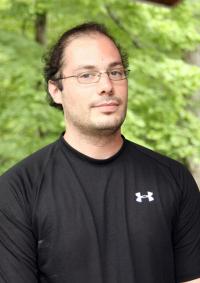 For those of us who dreaded making mistakes in math, the words of mathematics fellow Jean-Martin Albert (right) are a balm to the soul. “I want the students to fall into traps,” he said cheerfully, “to make mistakes and learn to see exactly where they made them and how to recover from them.” Jean-Martin’s enthusiasm for math shows that it can actually be fun, even useful. He received his M.Sc. in mathematics from the University of Calgary and is currently completing his doctorate in mathematics at McMaster University. Jean-Martin’s research interests are in mathematical logic, specifically something new and mysterious called continuous model theory and its applications to functional analysis.
For those of us who dreaded making mistakes in math, the words of mathematics fellow Jean-Martin Albert (right) are a balm to the soul. “I want the students to fall into traps,” he said cheerfully, “to make mistakes and learn to see exactly where they made them and how to recover from them.” Jean-Martin’s enthusiasm for math shows that it can actually be fun, even useful. He received his M.Sc. in mathematics from the University of Calgary and is currently completing his doctorate in mathematics at McMaster University. Jean-Martin’s research interests are in mathematical logic, specifically something new and mysterious called continuous model theory and its applications to functional analysis.
“I feel fortunate to be working at a place where I can just go and do some hands-on art sometimes,” said ceramics professor Martina Lantin. Last July, she and fellow art faculty member Cathy Osman attended a two-week silk-screening workshop at Haystack Mountain School of Crafts, in Maine. Martina was working on patterned, silkscreened wallpaper, to be used as part of her installation at the Brattleboro Museum and Art Center. “Having done plate installations on walls for many years, there is always the question of what lives behind the plates, and what is the relationship between the plates and wall. With the wallpaper, I see a conversation happening between the two.”
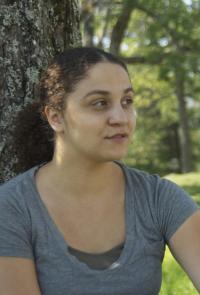 “Critical thinking is the bedrock of a functioning democracy and successful attempts to transform the world,” said social science fellow Renée Byrd (right), who is excited by Marlboro’s unique, student-driven approach to education. Renée received her bachelor’s degree in ethnic studies from Mills College, and is currently a Ph.D. candidate in feminist studies at the University of Washington. Her research focuses on contemporary prisons, neoliberal political rationalities and the politics of race, gender and sexuality. She has worked as a legal advocate for women prisoners in California and as a family advocate for youth involved in the juvenile justice system.
“Critical thinking is the bedrock of a functioning democracy and successful attempts to transform the world,” said social science fellow Renée Byrd (right), who is excited by Marlboro’s unique, student-driven approach to education. Renée received her bachelor’s degree in ethnic studies from Mills College, and is currently a Ph.D. candidate in feminist studies at the University of Washington. Her research focuses on contemporary prisons, neoliberal political rationalities and the politics of race, gender and sexuality. She has worked as a legal advocate for women prisoners in California and as a family advocate for youth involved in the juvenile justice system.
Once again, Spanish professor Rosario de Swanson confirmed for us that Spanish language, culture and literature have much to offer. In October, Rosario received the Victoria Urbano Award in drama, presented by the Asociación Internacional de Literatura y Cultura Femenina Hispánica (AILCFH) for her play titled Metamorphosis before the Obsidian Mirror: Monologue in Two Acts. She also presented a paper in September at an international conference at Howard University called “Africa and People of African Descent: Issues and Actions to Re-Envision the Future.” Her paper, “Dance as female affirmation in Ekomo, a novel from Equatorial Guinea,” was based on her recent research on Guinean literature (Potash Hill, Summer 2011, page 8).
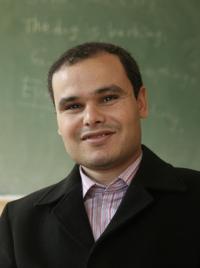 Fulbright Arabic Fellow Mohamed Jalal (right) considers the most exciting part of his fellowship the “nice and welcoming people.” This is a good thing, as it was a bit of a shock to come from the bustling port city of Mohammadia, Morocco, to a relatively quiet outpost like Marlboro. Mohamed received his bachelor’s degree in English studies from the Hassan II University of Mohammadia. Since then he has taught English in Mohammadia, most recently at the American Language Center. In addition to teaching Arabic, Mohamed has a strong interest in linguistics. After Marlboro, he hopes to continue teaching Arabic in the U.S. while he prepares for a Ph.D. program in applied linguistics.
Fulbright Arabic Fellow Mohamed Jalal (right) considers the most exciting part of his fellowship the “nice and welcoming people.” This is a good thing, as it was a bit of a shock to come from the bustling port city of Mohammadia, Morocco, to a relatively quiet outpost like Marlboro. Mohamed received his bachelor’s degree in English studies from the Hassan II University of Mohammadia. Since then he has taught English in Mohammadia, most recently at the American Language Center. In addition to teaching Arabic, Mohamed has a strong interest in linguistics. After Marlboro, he hopes to continue teaching Arabic in the U.S. while he prepares for a Ph.D. program in applied linguistics.
In an editorial published in The Commons, religion professot Amer Latif called for love, compassion and peace on the 10th anniversary of the 9/11 attacks. “As a Muslim-American, I find such inspiration in the life of the Prophet Muhammad, who, when asked how one could change the behavior of one’s children, replied, ‘Start with yourself,’” wrote Amer. He says that seeing all suffering equally is difficult work, work that begins with finding compassion within oneself. Amer also gave a series of talks at the Centre Congregation Church in Brattleboro on the intersection of Abrahamic faiths, as well as the keynote speech at the meeting of the Windham Union Association of UCC churches, “Understanding Islam through the words of Jesus.”
For those who think of terraces as nice places to grow rice or sip wine, math professor Matt Ollis has news for you. “A terrace is a structured pattern that might or might not exist in each of infinitely many mathematical objects called groups,” he said mysteriously. A recent issue of the Australasian Journal of Combinatorics includes a joint paper by Matt and former student Devin Willmott ’11 titled, “On twizzler, zigzag and graceful terraces.” “There are three somewhat separate problems addressed in the paper, tied together through their use of terraces,” said Matt. Devin collaborated with Matt on this paper as part of his Plan of Concentration on group theory.
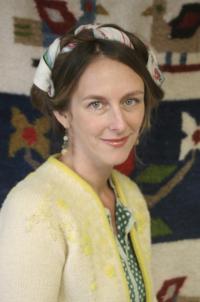 Marlboro students know Desha Peacock (right) as the director of career development, someone who can connect them with their next job prospect or internship. But Brattleboro knows her for The Desha Show, an eclectic human-interest show she produces on Brattleboro Community Television. In September, Desha received BCTV’s Best New Producer of the Year award, a great vote of confidence for her creative work. “The Desha Show is about beauty and inspiration, both inside and out,” she said. The show combines interviews with people who are living their dream with segments showcasing the work of “artists, interior designers, fashionistas and other creative types.”
Marlboro students know Desha Peacock (right) as the director of career development, someone who can connect them with their next job prospect or internship. But Brattleboro knows her for The Desha Show, an eclectic human-interest show she produces on Brattleboro Community Television. In September, Desha received BCTV’s Best New Producer of the Year award, a great vote of confidence for her creative work. “The Desha Show is about beauty and inspiration, both inside and out,” she said. The show combines interviews with people who are living their dream with segments showcasing the work of “artists, interior designers, fashionistas and other creative types.”
Continuing with her interdisciplinary research in disability studies, theater professor Brenda Foley presented a paper in September at a conference called “Chronic Illness: The Borderlands Between Health and Illness,” in Oxford, England. Her paper, “Passing Strange,” explores the ways we impose an unspoken cultural mandate that individuals with disabilities conceal their pain. “People with disabilities hide their pain, and the conditions that accompany it, behind carefully constructed presentational facades calibrated to suppress physical and emotional trauma,” said Brenda.
When visiting painting professor Craig Stockwell joined Marlboro for the fall semester, it was a bit of a family homecoming. The first settler of Marlboro in 1763 was Abel Stockwell, Craig’s great-great-great (etc.) grandfather, who died in 1777 of the “black fever” and is buried in the woods of Marlboro. “I have found it profoundly moving and intriguing to return to this hill town after so many generations,” said Craig, whose great-grandfather left the area in the 1800s to move to Massachusetts. The founder and artistic director of Artworks of Keene, as well as an adjunct professor at both Keene State College and Union Institute and University, Craig also served as a visiting artist in 2004 and as an outside examiner for several Marlboro students.
During her fall semester sabbatical, painting professor Cathy Osman spent time in the studio on a series of works that are collage based, using old sewing-pattern tissue layered with marks and patches of color. “Some of the new work can be read as landscape, reflecting the flood waters of the past month, or as an image complex with a scaffolding, referencing industrialization and chaos,” said Cathy. Some of the pieces include constructions of balsa wood that evoke broken bridges, fish netting or window blinds. “They have a sculptural presence on the wall, but also a fragility—the tissue paper is skin-like and the balsa wood weightless, giving the work a sense of impermanence—issues which are current to me now.”
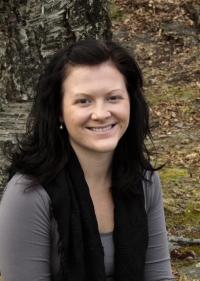 “Social and professional networking is dramatically changing how people look for jobs and prepare for interviews,” wrote student life coordinator Zoe Ogilvie (right) in the September/October issue of InChemistry. In an article titled “Upgrading Your Online Image,” co-authored with Lisa Marshall, she describes how to make the digital transition from college student to scientific professional. Zoe, who received her master’s degree in media and professional communications from Fairleigh Dickenson University, works for the career development office at Marlboro. In her article she shares sage advice and specific strategies useful to prospective employees in any field, including avoiding faux pas like sharing inappropriate photos or badmouthing previous employers.
“Social and professional networking is dramatically changing how people look for jobs and prepare for interviews,” wrote student life coordinator Zoe Ogilvie (right) in the September/October issue of InChemistry. In an article titled “Upgrading Your Online Image,” co-authored with Lisa Marshall, she describes how to make the digital transition from college student to scientific professional. Zoe, who received her master’s degree in media and professional communications from Fairleigh Dickenson University, works for the career development office at Marlboro. In her article she shares sage advice and specific strategies useful to prospective employees in any field, including avoiding faux pas like sharing inappropriate photos or badmouthing previous employers.